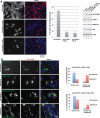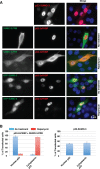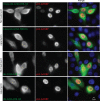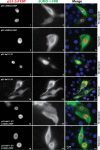p53 SUMOylation promotes its nuclear export by facilitating its release from the nuclear export receptor CRM1
- PMID: 23825024
- PMCID: PMC3756925
- DOI: 10.1091/mbc.E12-10-0771
p53 SUMOylation promotes its nuclear export by facilitating its release from the nuclear export receptor CRM1
Abstract
Chromosomal region maintenance 1 (CRM1) mediates p53 nuclear export. Although p53 SUMOylation promotes its nuclear export, the underlying mechanism is unclear. Here we show that tethering of a small, ubiquitin-like modifier (SUMO) moiety to p53 markedly increases its cytoplasmic localization. SUMO attachment to p53 does not affect its oligomerization, suggesting that subunit dissociation required for exposing p53's nuclear export signal (NES) is unnecessary for p53 nuclear export. Surprisingly, SUMO-mediated p53 nuclear export depends on the SUMO-interacting motif (SIM)-binding pocket of SUMO-1. The CRM1 C-terminal domain lacking the NES-binding groove interacts with tetrameric p53, and the proper folding of the p53 core domain, rather than the presence of the N- or C-terminal tails, appears to be important for p53-CRM1 interaction. The CRM1 Huntington, EF3, a subunit of PP2A, and TOR1 9 (HEAT9) loop, which regulates GTP-binding nuclear protein Ran binding and cargo release, contains a prototypical SIM. Remarkably, disruption of this SIM in conjunction with a mutated SIM-binding groove of SUMO-1 markedly enhances the binding of CRM1 to p53-SUMO-1 and their accumulation in the nuclear pore complexes (NPCs), as well as their persistent association in the cytoplasm. We propose that SUMOylation of a CRM1 cargo such as p53 at the NPCs unlocks the HEAT9 loop of CRM1 to facilitate the disassembly of the transporting complex and cargo release to the cytoplasm.
Figures











References
-
- Askjaer P, Jensen TH, Nilsson J, Englmeier L, Kjems J. The specificity of the CRM1-Rev nuclear export signal interaction is mediated by RanGTP. J Biol Chem. 1998;273:33414–33422. - PubMed
-
- Carter S, Bischof O, Dejean A, Vousden KH. C-terminal modifications regulate MDM2 dissociation and nuclear export of p53. Nat Cell Biol. 2007;9:428–435. - PubMed
-
- Carter S, Vousden KH. p53-Ubl fusions as models of ubiquitination, sumoylation and neddylation of p53. Cell Cycle. 2008;7:2519–2528. - PubMed
-
- Chang CC, et al. Structural and functional roles of Daxx SIM phosphorylation in SUMO paralog-selective binding and apoptosis modulation. Mol Cell. 2011;42:62–74. - PubMed
Publication types
MeSH terms
Substances
Grants and funding
LinkOut - more resources
Full Text Sources
Other Literature Sources
Research Materials
Miscellaneous

